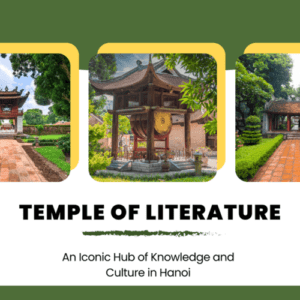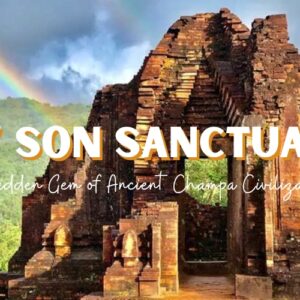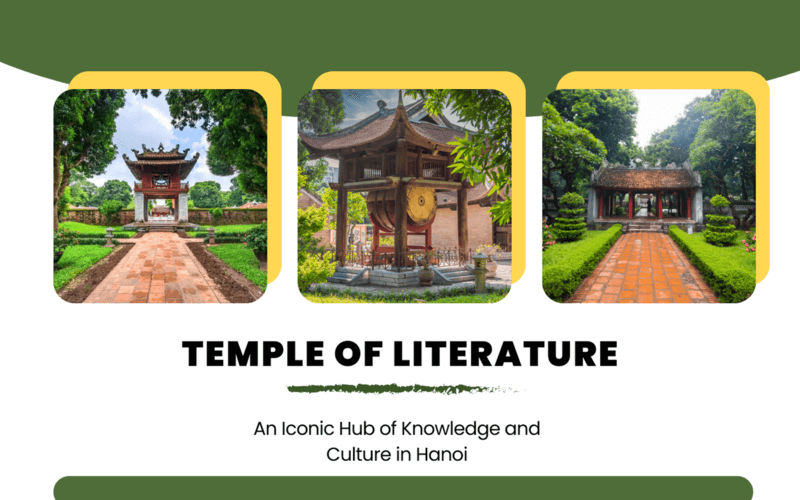
Renowned as Vietnam’s oldest university, the Temple of Literature in Hanoi holds within its walls the essence of the nation’s feudal history and serves as a repository of its rich cultural heritage. In this article, we will provide you with captivating insights into the Temple of Literature, known as Van Mieu – Quoc Tu Giam in Vietnamese, a cherished symbol of Vietnam’s capital city. Brace yourself for a deluge of historical information that is sure to captivate your mind.
Essential Information for Tourists
Location of the Temple of Literature
The Temple of Literature, also known as Van Mieu, is located in the Dong Da district, in the middle of 4 bustling streets: Nguyen Thai Hoc, Van Mieu, Quoc Tu Giam, and Ton Duc Thang. It is stated at No. 58, Quoc Tu Giam Street, Dong Da District.
Opening hours and Entrance fees
Operating hours: The Temple of Literature is open daily from 8 am to 5:30 pm, except Mondays and national holidays.
Admission fees:
- Adults: 30,000 VND.
- Students and pupils: 15,000 VND (valid student identification cards are required).
- Children under 15 years old: Free
Regulations of the Temple of Literature
- Dress modestly and refrain from wearing revealing attire.
- Uphold a peaceful and respectful atmosphere, especially in the areas designated for worship.
- Adhere to the regulations set by the management board and show respect towards the relics.
- Avoid touching the turtle’s head or sitting on the doctor’s beer.
- Carry cash, as credit cards are not accepted at the ticket counter.
The History and Signification of the Temple of Literature
History of Formation
Van Mieu – Quoc Tu Giam comprises two primary sections: the Temple of Literature and the Imperial Academy.
The Temple of Literature (Van Mieu) was established in August 1070 under the rule of King Ly Thanh Tong, serving as a tribute to Confucius and revered scholars of that era. In 1076, King Ly Nhan Tong established the Imperial Academy (Quoc Tu Giam) as an educational institution for the royal family and noble households. It holds the distinction of being Vietnam’s oldest university.
During the reign of King Tran Thai Tong in 1253, the Imperial Academy underwent expansion, opening its doors to students from all backgrounds, including those from humble origins who demonstrated exceptional academic potential. In 1484, King Le Thanh Tong organized a rigorous examination and erected steles to honor those who successfully passed the doctoral exam.
The signification of The Temple
The Temple of Literature holds a revered status as one of Hanoi’s most sacred sites. Its current form stands as a magnificent testament to Indochinese architecture, showcasing the amalgamation of Vietnam’s imperial histories spanning nearly a millennium. Beyond its architectural splendor, the temple holds immense educational significance. During the graduation season, it becomes a vibrant hub, adorned with the presence of countless students in graduation gowns and traditional Ao Dai attire. This enchanting scene unfolds as they strike poses for photographs, eagerly awaiting blessings to commemorate their academic achievements.
The Unique Structure of the Temple of Literature Complex
This complex of historical significance spans approximately 54,331 square meters and encompasses a variety of structures, including Ho Van, Temple of Literature, Quoc Tu Giam, Giam Garden, and Khue Van Cac. Surrounding the premises are weathered brick walls that bear the marks of time.
The Temple of Literature showcases the distinctive architectural style of the early Nguyen Dynasty. The different sections within the temple are arranged in accordance with the traditional North-South axis, with each zone and layer clearly demarcated. For enthusiasts of architecture, the Temple of Literature stands as an exemplary representation of Vietnam’s enduring architectural heritage, characterized by its use of wood and tile materials. Along the pathways, ancient trees, aged over a hundred years, bear witness to the ebbs and flows of history.
The Great Portico – Entrance to the way
In the early 20th century, the grand portico of the Temple of Literature underwent a meticulous reconstruction. Constructed using bricks, this impressive gate boasts three entrances adorned with elegant eight-roof structures. The central gateway, marked with the inscription “Van Mieu Mon” (Gate of the Temple of Literature) in Chinese characters, stands prominently. Positioned before the portico, two dragons hailing from the 15th century during the Le Dynasty captivate visitors with their ancient allure. Stepping through the gate and casting your gaze upward, the central door reveals a remarkable sight: five intricately carved figures. Among them stands Confucius himself, occupying the central position, while the four surrounding figures represent his revered students.
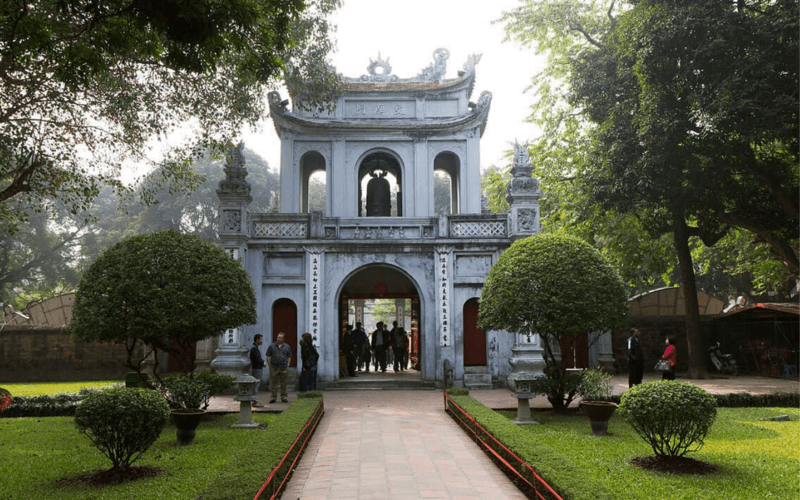
The Great Portico
The First Courtyard – The Great Middle Gate (Dai Trung Gate)
The imposing Great Middle Gate marks the first courtyard. Crowned atop this gate is a fish sculpture, imbued with a fascinating legend. As the tale goes, an ancient competition for fish was organized by Gods, wherein those capable of leaping over mighty ocean waves and reaching the other side would transform into majestic dragons. Symbolically, the fish embodies the diligent students who aspire to overcome every examination challenge and ceaselessly pursue knowledge.
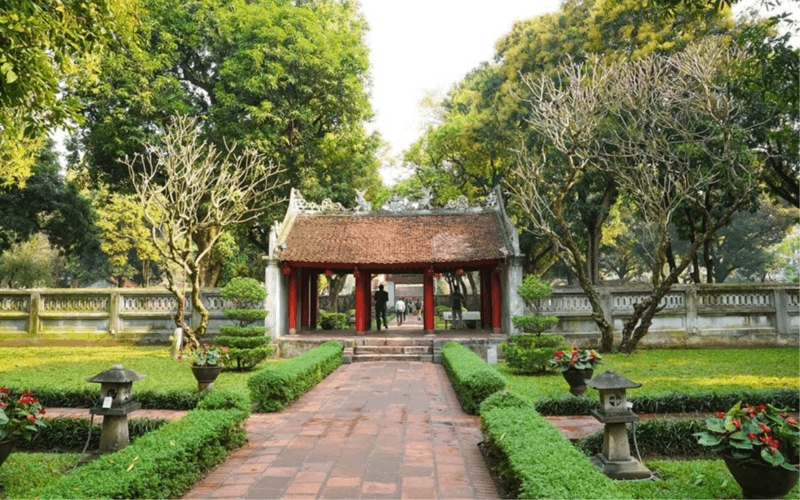
The First Courtyard – The Great Middle Gate
The Second Courtyard – The Pavilion of Constellation (Khue Van Cac)
The Pavilion of Constellation, despite its modest size, exudes an exquisite sense of balance and aesthetic harmony. This architectural gem showcases four sturdy brick pillars that uphold the graceful wooden framework above. Adorned with four round doors, delicate handrails, and a meticulously crafted roof, the pavilion captivates with its intricate design. This iconic structure holds deep significance for Hanoi, so much so that its image is immortalized on Vietnam’s 100,000 VND banknote.
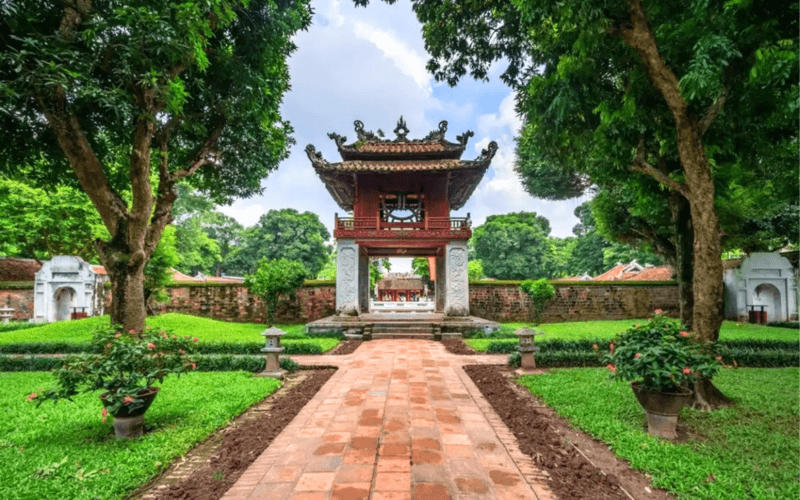
Khue Van Cac
The Third Courtyard – The Well of Heavenly Clarity (Thien Quang Well)
Nestled within the Temple of Literature, the Well of Heavenly Clarity encompasses a serene courtyard featuring a square-shaped pond. In one corner, a collection of stone turtles can be found, carrying immense stelae. These stelae serve as eloquent tributes to the principles of Confucianism, paying homage to the revered kings.
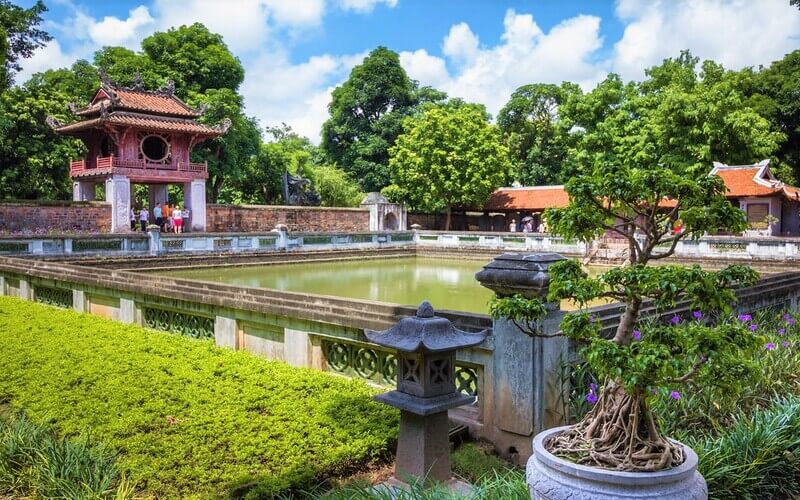
The Well of Heavenly Clarity
The Fourth Courtyard – The Gate to Great Success (Dai Thanh Sanctuary, The Shrine Area)
Within the fourth courtyard, known as the “Gate to Great Success” in Vietnamese, lies an enchanting House of Ceremonies and a sanctuary devoted to Confucius. This area captivates with its striking crimson columns and intricate wooden ceilings adorned with gracefully suspended vintage lanterns. These elements combine to create a captivating ambiance with reverence and timeless beauty.
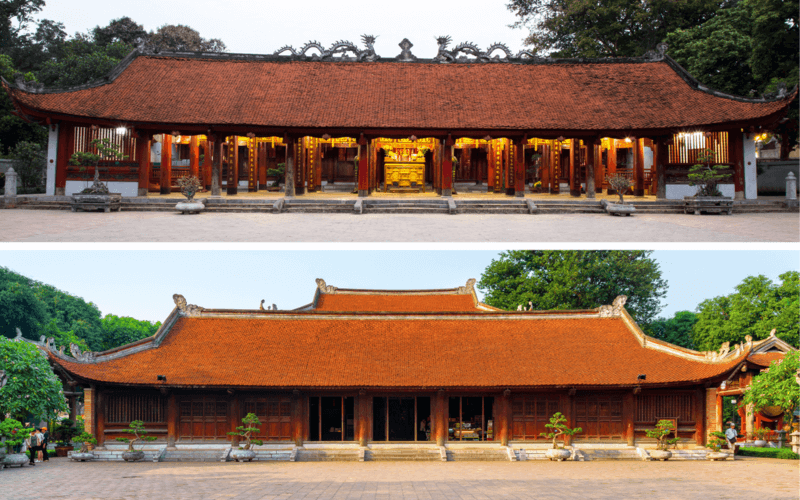
The Gate to Great Success
The Fifth Courtyard – The Grounds of Imperial Academy (Khai Thanh Temple, Thai Hoc House)
Within the fifth courtyard, an imposing two-story structure stands as a testament to the rich educational legacy of the Imperial Academy. The first floor houses a remarkable statue of Chu Van An, the esteemed inaugural rector of the academy. Ascend to the second floor, you will discover a reverential space devoted to honoring the three influential kings who played pivotal roles in establishing and safeguarding the academy.
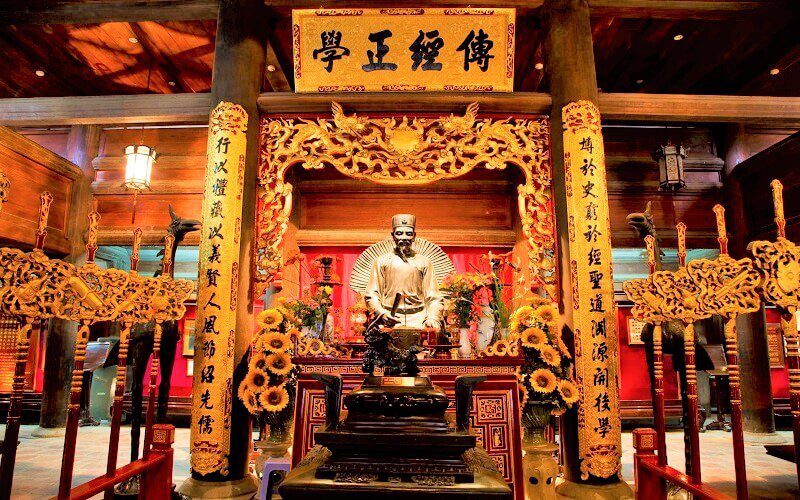
The Grounds of Imperial Academy
Doctoral Steles in the Temple of Literature Complex
Adjacent to the Well of Heavenly Clarity, there are 82 stelae known as the Doctors’ Steles, elegantly placed on stone tortoises. These stelae bear inscriptions that record the achievements of successful candidates who excelled in the prestigious state royal examinations held at the National Academy between 1442 and 1779. These stelae hold immense historical significance and are treasured as valuable resources. Traditionally, it was common for students to gently stroke the heads of the tortoises in hopes of receiving good fortune before their crucial examinations. However, to preserve the integrity of these stone sculptures, touching them is strictly prohibited within the temple premises.
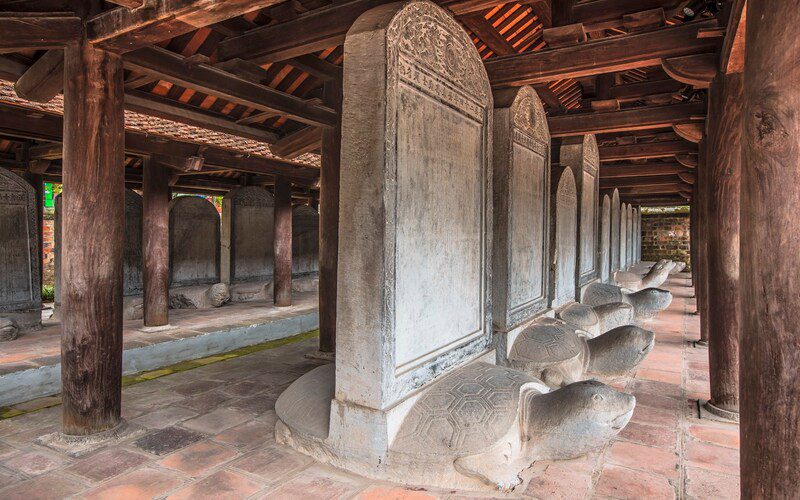
82 Doctors’ Stelae – Tangible cultural heritage of Literature Temple
Best Places to Visit near the Temple of Literature
The Temple of Literature, together with the following tourist destinations in Hanoi, will make up a wonderful cultural and historical experience for those visiting the capital of Vietnam.
Ho Chi Minh Mausoleum
In close proximity, the renowned Ho Chi Minh Mausoleum stands as a striking edifice, constructed in a grand architectural style. It stands as a powerful symbol, representing profound reverence and admiration for Uncle Ho’s exemplary leadership and remarkable contributions to the nation. Visitors have the opportunity to pay their respects and gain insights into his momentous endeavors for the country.
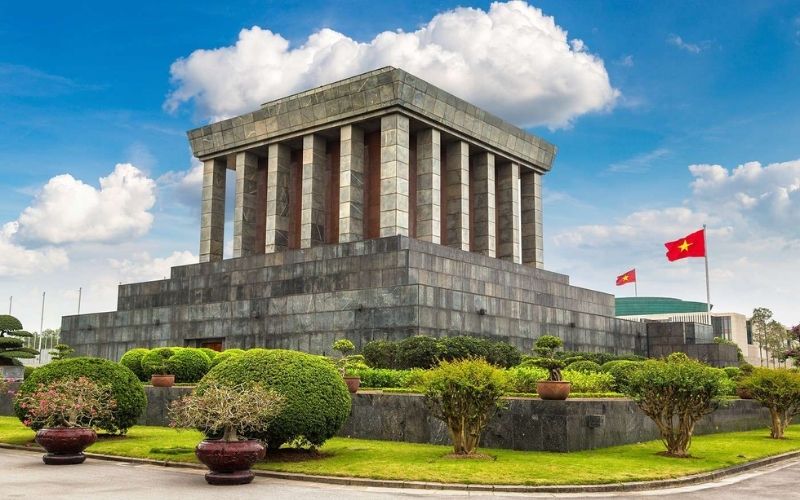
Ho Chi Minh Mausoleum
Hoa Lo Prison
Popularly referred to as the “Hanoi Hilton,” the Hoa Lo Prison serves as an intriguing museum that offers a captivating window into the history of the country. Today, it stands as a museum that provides valuable insights into the past and the experiences of the prisoners who were confined within its formidable walls. Through a collection of exhibits, visitors can explore a wealth of artifacts, photographs, and narratives that vividly portray the hardships and indomitable spirits of those held captive within the prison.
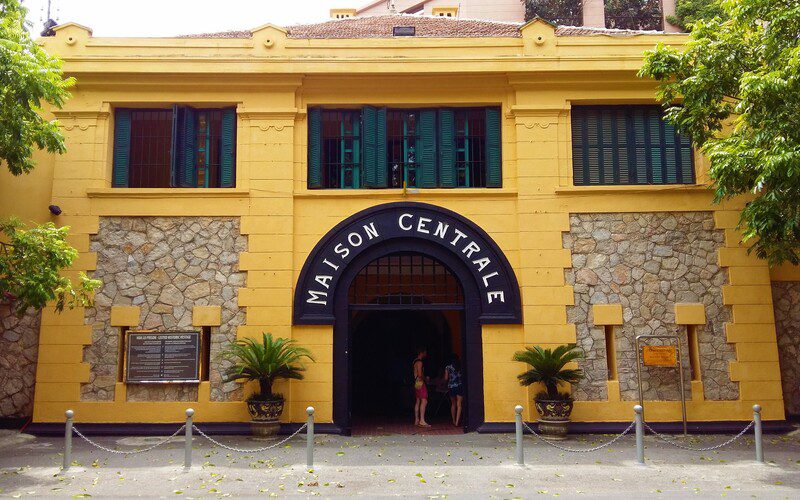
Hoa Lo Prison
Hoan Kiem Lake
Hoan Kiem Lake is one of the most famous and beloved landmarks in Hanoi. According to folklore, Emperor Ly Thai To was given a magical sword by a golden turtle to help him defeat the Chinese invaders. After the victory, the turtle reclaimed the sword and disappeared into the lake’s depths, hence the name “Lake of the Returned Sword”. Situated in the heart of Hanoi, this picturesque lake offers a tranquil escape from the city’s hustle and bustle. The lake is surrounded by beautiful scenery and is home to the iconic red-painted Huc Bridge and Ngoc Son Temple.
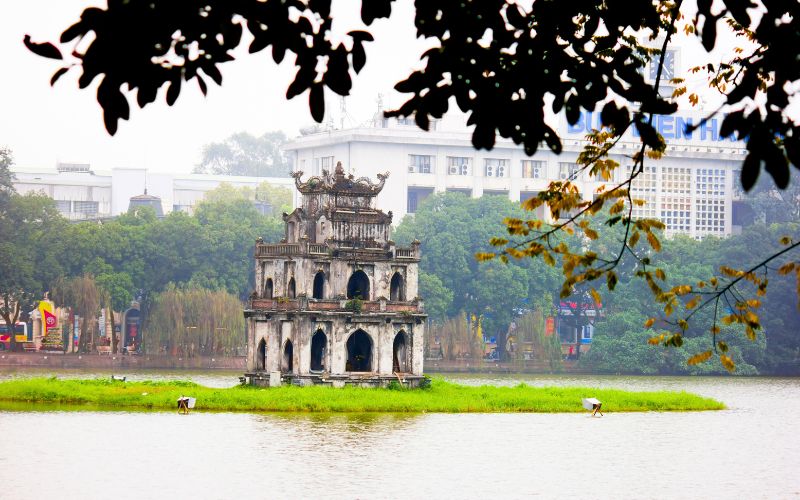
Hoan Kiem Lake
Getting to the Temple of Literature
Taxi/Grab/Private car
Getting around in Hanoi is made easy with the availability of taxis and ride-sharing services like Grab. Whether you choose a traditional taxi or opt for a Grab car, both options are convenient and readily accessible. From your current location, you can easily book a taxi or Grab and provide the driver with the address of the Temple of Literature. This allows for a seamless door-to-door transportation experience.
For anyone who likes a convenient transportation option, you can consider renting a car with a private driver. This allows you to have a dedicated driver who is well-versed in navigating Hanoi and often possesses English language skills. They can offer valuable insights into the city, including historical landmarks, delectable cuisines, popular entertainment venues, and more. Contact us for further details and assistance regarding this service.
Public Bus
Hanoi has an extensive public bus network. You can check the bus routes that pass near the Temple of Literature and look for the nearest bus stop. Take the bus that goes in the direction of the temple and get off at the nearest stop. Be prepared to navigate the bus system and check the bus schedule for timings. Currently, several bus routes are stopping near the Temple of Literature: lines 2, 23, lines 32, 38, and 41. In addition, you can refer to the double-decker bus service to make it easier to move between attractions in the city.
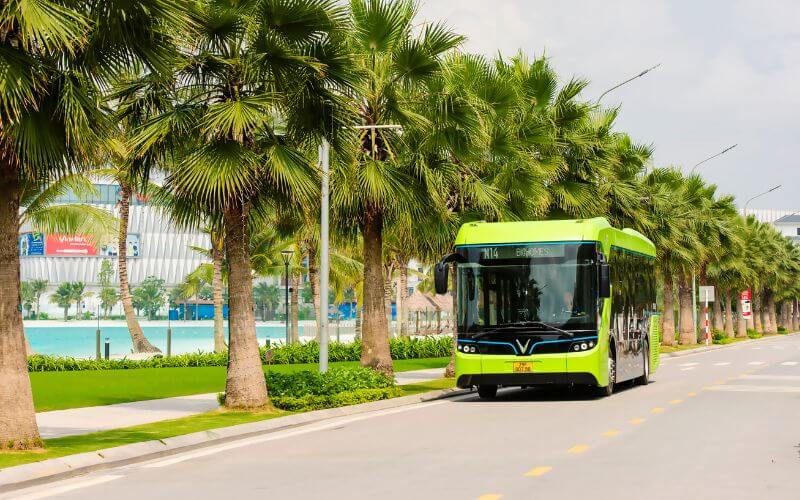
Hanoi Bus
Cyclo/Rickshaw
In the tourist areas of Hanoi, you can find cyclos, which are traditional cycle rickshaws. If you prefer a slower and more traditional mode of transportation, you can opt for a cyclo ride to the Temple of Literature. When taking a cyclo, it is customary to negotiate the fare with the driver before starting the journey. Once agreed upon, the cyclo driver will pedal you to your destination, allowing you to soak in the surroundings and enjoy a leisurely ride to the Temple of Literature.
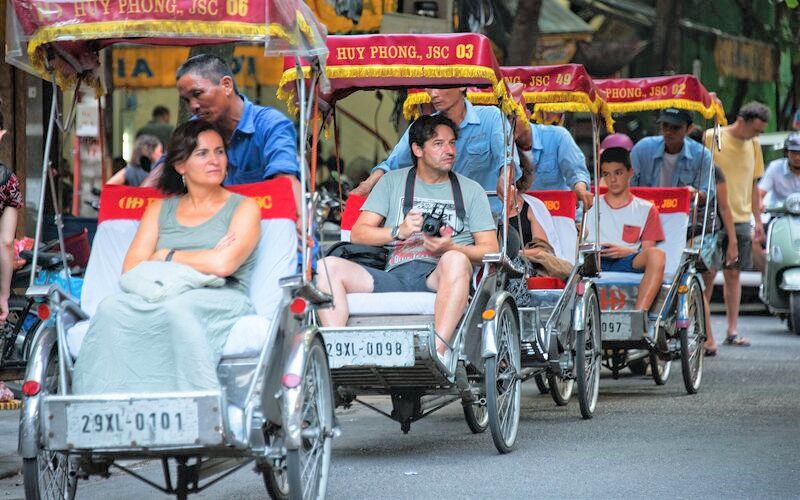
Cyclo in Old Quater
Walking to the Temple of Literature
If you are in the vicinity or staying nearby, walking to the Temple of Literature is a great option. Hanoi is known for being a walkable city, and strolling to your destination offers an opportunity to immerse yourself in the local atmosphere. As you make your way to the Temple of Literature on foot, you can explore the charming streets, discover hidden gems, and truly experience the city at your own pace.
The Temple of Literature surpasses being a mere symbol of Vietnam’s historical legacy. It stands as a testament to the nation’s pride and honors the countless generations of scholars who dedicated themselves to preserving the profound wisdom of antiquity. Amidst a region abundant with temples, this particular site in the lively capital of Hanoi is an absolute must-visit, offering a unique and enriching experience that should not be overlooked during your stay in Vietnam. Do not hesitate to contact us if you’re planning to travel to Hanoi shortly.
